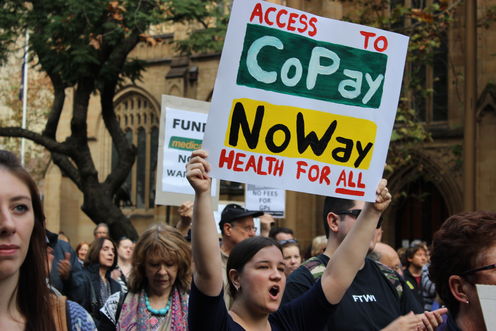
Bulk billing without restrictions has been a feature of the Australian health system since the introduction of Medicare in 1984. It is particularly important in general practice, as it means any Australian can see a primary care doctor without having to pay out-of-pocket costs. In 2012/13, 81% of GP consultations were bulk billed.
The 2014 budget introduced the notion of a co-payment to apply to the first ten GP visits. This has been one of the more unpopular budget measures, largely on the basis of the effect on the disadvantaged. The AMA today released its awaited alternative.
So how does the Australian Medical Association (AMA) plan compare with the government’s?
As the table shows, it retains the notion of a co-payment, but only for general patients and only as long they are not receiving chronic disease management, services of a preventive nature, or mental health care. In other respects, it sticks with the status quo.

Around half of all GP visits result in further treatments such as pathology and imaging services, which will incur further co-payments under both the AMA and Government proposals; although the AMA has recommended deferring the introduction of these by two years.
So, does the AMA plan protect the disadvantaged while sending a price signal to the people with the means to contribute more to the costs of their health care? And is it an alternative way for the government to reach its objectives?
Around 5.5 million Australians hold some type of concession-card. Eligibility largely depends on age, income and circumstances. These people will be protected from any new co-payments (not all card holders are bulk billed now).
But differences in eligibility criteria suggest that there are plenty of relatively poor families who do not qualify for a card, whereas many relatively wealthy retirees do.
In order to qualify for the low-income health care card, for example, a single parent with one child can earn a maximum of around $47,000 per year, whereas a couple of retirement age can earn a maximum of $80,000 per year, face no asset test, and still qualify for the seniors health care card.
This shows the concession card is a very blunt instrument to determine the ability for patients to pay for their health care, and without the option of bulk billing, more low-income people will fall through the safety net cracks.
Over 72% of all bulk-billed items are provided to children aged under 16 or concession-card holders. The vast majority of those without a concession card are not bulk-billed and already face co-payments to visit their GP. When they do, they pay, on average, $28.58 after the Medicare rebate, or over $60 at the visit for most consultations.
For the vast majority of these people, the proposal will have no effect as they already incur a co-payment well in excess of the minimum co-payment of $6.15 that has been proposed by the AMA.
Indeed, the AMA’s proposed price signal for GP visits is only likely to affect those Australians who do not have a concession card and who currently visit a bulk-billing GP (or one who charges less than the proposed minimum co-payment).

The rationale for the introduction of a $7 co-payment has been confused, and three reasons have been advanced: the need to reduce Medicare expenditure; the need to contribute to the budget bottom line; and the need to establish a price signal which will increase the efficiency of health care service delivery.
Medicare expenditure can be reduced by reducing rebates or reducing use. The government proposal aimed to do both.
Evidence shows that price signals discourage use by the disadvantaged, but also that reducing primary care use has not resulted in long-term cost savings to the system.
Under the government proposal, increased revenue from co-payments was not directed to the budget deficit but to a medical research fund. This would reduce government debt as it only the interest was to be returned to research.
The AMA proposal, while providing additional protection to children and concession-card holders, seems to contribute to the general practice bottom line rather than the government budget position. Doctors would be better off and according to Health Minister Peter Dutton, the AMA plan would wipe out 97% of the government’s $3.5bn savings.
The efficiency of the health system and its long-term sustainability is worth attention. But Australia does not have an immediate fiscal crisis due to health expenditure. It’s time to design a system of delivering health care that addresses 21st century health problems with 21st century technologies and knowledge.
Jane Hall receives funding from the NHMRC and APHCRI.
Kees Van Gool receives funding from the Australian Primary Health Care Institute (APHCRI).
